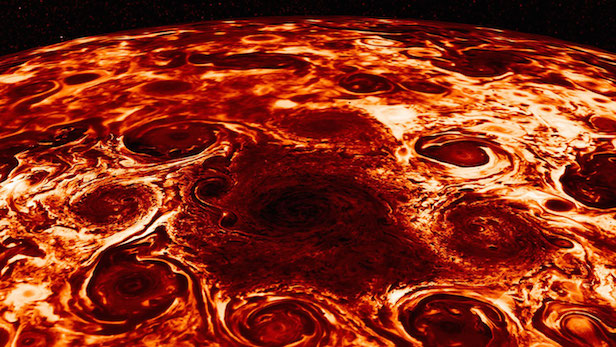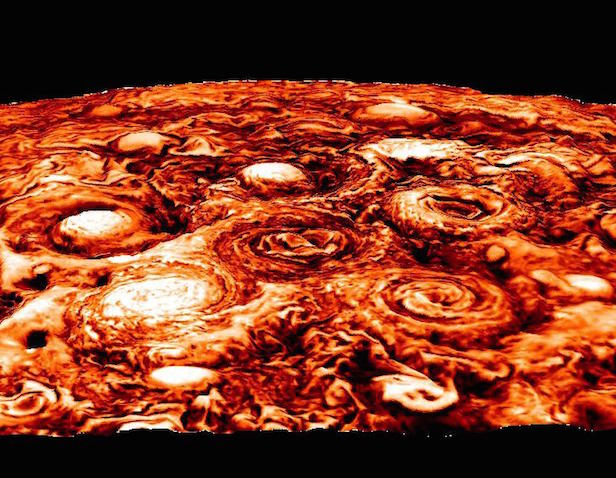Juno Update: Jupiter’s clouds delve deeper than expected
The latest scientific results from NASA’s Juno spacecraft unveil new information about the planets cloud tops, along with some amazing new images

The composite image was derived from the data collected by Juno’s JIRAM instrument, showing the north pole of Jupiter, its central cyclone and the encompassing eight smaller cyclones. Imagre credit: NASA/JPL-Caltech/SwRI/ASI/INAF/JIRAM
NASA’s Juno spacecraft has sent back more data about the largest planet in the Solar System, Jupiter, revealing that its atmospheric winds stay as strange and unstable when you head towards the planet’s core. Such a revelation will help astronomers understand Jupiter’s interior structure, core mass and, eventually, its true origins.
This discovery comes as part of a four-article collection of recent scientific results from the Juno spacecraft, released on 8 March 2018. Along with the intriguing news about Jupiter’s deeply buried storms is that also its massive cyclones, reeking havoc at the north and south poles, are unlike anything they’ve seen in the Solar System.
“These astonishing science results are yet another example of Jupiter’s curve balls, and a testimony to the value of exploring the unknown from a new perspective with next-generation instruments. Juno’s unique orbit and evolutionary high-precision radio science and infrared technologies enabled these paradigm-shifting discoveries,” says Scott Bolton, principal investigator of Juno from the Southwest Research Institute, San Antonio, United States. “Juno is only about one third the way through its primary mission, and already we are seeing the beginnings of a new Jupiter.”
How far the famous contrasting belts of Jupiter are buried has remained an unsolvable riddle for decades, until now. Thanks to the gravity measurements made by Juno during its close encounters, the answer has been revealed. Luciano Iess, Juno co-investigator from Sapienza University of Rome, explains, “Juno’s measurement of Jupiter’s gravity field indicates a north-south asymmetry, similar to the asymmetry observed in its zones and belts.”
Asymmetry within a gas planet only originates from ferocious flows deep inside the planet. On Jupiter, the noticeable eastward and westward jet streams are similar to the north and south asymmetry. The deeper the jets are, the more mass there is, and consequently, this leads to a stronger gravity reading. This is how astronomers deduced the depth of the jet streams from the magnitude of the asymmetrical gravity readings.
“Galileo viewed the stripes on Jupiter more than 400 years ago,” says Yohai Kaspi, Juno co-investigator from the Weizmann Institute of Science, Rehovot, Israel. “Until now, we only had a superficial understanding of them and have been able to relate these stripes to cloud features along Jupiter’s jets. Now, following the Juno gravity measurements, we know how deep the jets extend and what their structure is beneath the visible clouds. It’s like going from a 2-D picture to a 3-D version in high definition.”
The highly anticipated results rendered a surprised response, as it appears that the weather layer of Jupiter extends much further, and is therefore more massive, than first thought. The Jovian weather layer, which extends from the very top of the clouds to a depth of 3,000 kilometres (1,900 miles), contains just one percent of Jupiter’s mass, equating to roughly three times the mass of Earth. “By contrast, Earth’s atmosphere is less than one millionth of the total mass of Earth,” says Kaspi “The fact that Jupiter has such a massive region rotating in separate east-west bands is definitely a surprise.”

Also derived from data collected by Juno’s JIRAM instrument, Jupiter’s south pole exhibits a large central cyclone with only five cyclones surrounding it. Image credit: NASA/JPL-Caltech/SwRI/ASI/INAF/JIRAM
This result will aid researchers in their conquest to truly understand the nature of Jupiter, and the mechanisms that churn these strong jet streams. Additionally, the gravity signature of the jets is intertwined with the gravity signal from Jupiter’s core.
Further results, released from this influx of Jovian knowledge, include the suggestion that beneath the weather layer, the planet rotates almost as a rigid entity. “This is really an amazing result, and future measurements by Juno will help us understand how the transition works between the weather layer and the rigid body below,” says Tristan Guillot, a Juno co-investigator from the Université Côte d’Azur, Nice, France. “Juno’s discovery has implications for other worlds in our solar system and beyond. Our results imply that the outer differentially-rotating region should be at least three times deeper in Saturn and shallower in massive giant planets and brown dwarf stars.”
Accompanying the latest results of Jupiter were amazing images of its poles, captured by Juno’s Jovian Infrared Auroral Mapper (JIRAM) instrument. Independent to whether it was night or day, JIRAM took images of the planet’s infrared light emerging from as far down as 50 to 70 kilometres (30 to 45 miles) below Jupiter’s cloud tops.
“Prior to Juno we did not know what the weather was like near Jupiter’s poles. Now, we have been able to observe the polar weather up-close every two months,” says Alberto Adriani, Juno co-investigator from the Institute for Space Astrophysics and Planetology, Rome, Italy. “Each one of the northern cyclones is almost as wide as the distance between Naples, Italy and New York City – and the southern ones are even larger than that. They have very violent winds, reaching, in some cases, speeds as great as 220 miles-per-hour (350 kilometres-per-hour). Finally, and perhaps most remarkably, they are very close together and enduring. There is nothing else like it that we know of in the solar system.”
The Jovian poles are distinctly different to its orange and white belts, which we have been observing for, from Earth, for centuries. The north pole is dominated by a central cyclone surrounded by eight circumpolar cyclones with diameters ranging from 4,000 to 4,600 kilometres (2,500 to 2,900 miles). The southern pole also contains a central cyclone, however it is surrounded by five larger cyclones with diameters ranging from 5,600 to 7,000 kilometres (3,500 to 4,300 miles). Almost all of the cyclones at both poles are densely packed together, meaning that their spiral arms come in contact with adjacent cyclones. Despite their close quarters, the cyclones have maintained their individual morphologies throughout the seven months of prior observations. “The question is, why do they not merge?” says Adriani. “We know with Cassini data that Saturn has a single cyclonic vortex at each pole. We are beginning to realize that not all gas giants are created equal.”
At the time of writing, Juno has completed 10 perijoves – which is another term for a close encounter over Jupiter’s cloud tops – covering a distance of almost 200 million kilometres (122 million miles), and still counting. These encounters have been occurring since the spacecraft entered the planet’s orbit, in 4 July 2016, and the next one will be on 1 April 2018. In these perijoves, Juno will get as close as 3,500 kilometres (2,200 miles) above the cloud tops.
Keep up to date with the latest reviews in All About Space – available every month for just £4.99. Alternatively you can subscribe here for a fraction of the price!




